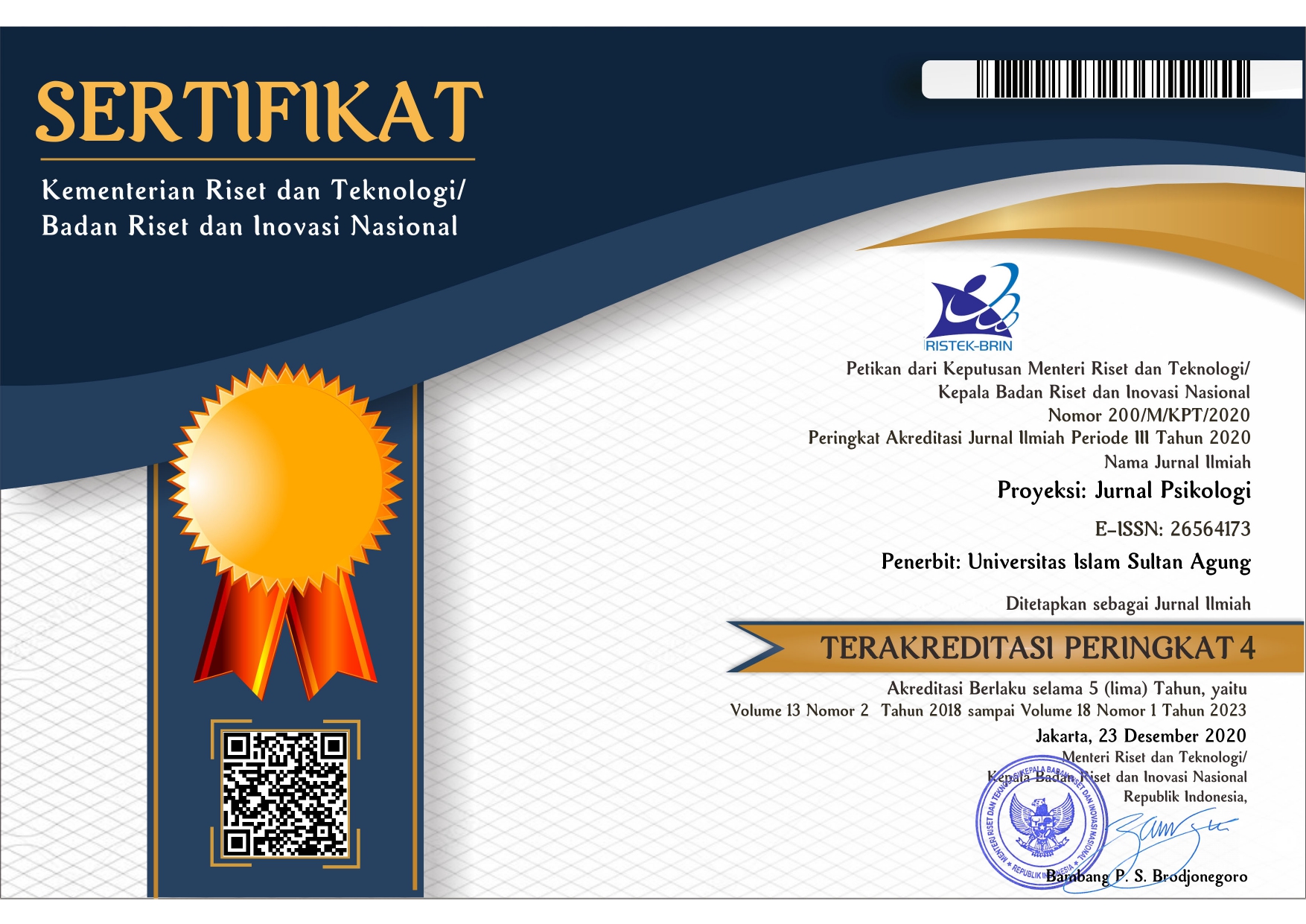RELIGIUSITAS DAN RASA SYUKUR SEBAGAI PREDIKTOR KESEHATAN MENTAL NARAPIDANA
Abstract
Keywords
Full Text:
PDFReferences
Ancok, D., & Suroso, F. N. (2011). Psikologi agama. Yogyakarta: Pustaka Pelajar.
Aziz, R. (2015). Aplikasi model rasch dalam pengujian alat ukur kesehatan mental di tempat kerja. Psikoislamika: Jurnal Psikologi Dan Psikologi Islam, 12(2), 29. https://doi.org/10.18860/psi.v12i2.6402
Bonelli, R., Dew, R. E., Koenig, H. G., Rosmarin, D. H., & Vasegh, S. (2012). Religious and spiritual factors in depression: Review and integration of the research. Depression Research and Treatment, 2012. https://doi.org/10.1155/2012/962860
Deng, Y., Xiang, R., Zhu, Y., Li, Y., Yu, S., & Liu, X. (2019). Counting blessings and sharing gratitude in a Chinese prisoner sample: Effects of gratitude-based interventions on subjective well-being and aggression. Journal of Positive Psychology, 14(3), 303–311. https://doi.org/10.1080/17439760.2018.1460687
Emmons, R. A., & Crumpler, C. A. (2000). Gratitude as a human strength: Appraising the evidence. Journal of Social and Clinical Psychology, 19(1), 56–69. https://doi.org/10.1521/jscp.2000.19.1.56
Fitzgerald, P. (1998). Gratitude and justice. Ethics, 109(1), 119–153. https://doi.org/10.1086/233876
Glock, C. Y., & Stark, R. (1965). Religion and society in tension. Chicago: Rand McNally
Heigel, C. P., Stuewig, J., & Tangney, J. P. (2010). Self-reported physical health of inmates: Impact of incarceration and relation to optimism. Journal of Correctional Health Care, 16(2), 106–116. https://doi.org/10.1177/1078345809356523
Hidayati, N. O., Hanafilah, F. F., Sundari, I., Alam, S. P., Fadillah, V. N., Keperawatan, F., & Padjadjaran, U. (2021). Aspek spiritual terhadap resiko bunuh diri narapidana. 9(3), 703–710.
Huber, S., & Huber, O. W. (2012). The Centrality of Religiosity Scale (CRS). Religions, 3(3), 710–724. https://doi.org/10.3390/rel3030710
Idler, E. (2008). The psychological and physical benefits of spiritual/religious practices. Spirituality in Higher Education Newsletter, 4(2), 1–5.
Jang, S. J., Johnson, B. R., Hays, J., Hallett, M., & Duwe, G. (2018). Existential and virtuous effects of religiosity on mental health and aggressiveness among offenders. Religions, 9(6), 1–19. https://doi.org/10.3390/rel9060182
Jans-Beken, L., Jacobs, N., Janssens, M., Peeters, S., Reijnders, J., Lechner, L., & Lataster, J. (2020). Gratitude and health: An updated review. Journal of Positive Psychology, 15(6), 743–782. https://doi.org/10.1080/17439760.2019.1651888
Johnson, L., Gutridge, K., Parkes, J., Roy, A., & Plugge, E. (2021). Scoping review of mental health in prisons through the COVID-19 pandemic. BMJ Open, 11(5), 1–8. https://doi.org/10.1136/bmjopen-2020-046547
Kingston, P., Le Mesurier, N., Yorston, G., Wardle, S., & Heath, L. (2011). Psychiatric morbidity in older prisoners: unrecognized and undertreated. International Psychogeriatrics / IPA, 23(8), 1354–1360. https://doi.org/10.1017/S1041610211000378
Kothari, R., Forrester, A., Greenberg, N., Sarkissian, N., & Tracy, D. K. (2020). COVID-19 and prisons: Providing mental health care for people in prison, minimising moral injury and psychological distress in mental health staff. Medicine, Science and the Law, 60(3), 165–168. https://doi.org/10.1177/0025802420929799
Listiyandini, R. A., Nathania, A., Syahniar, D., Sonia, L., & Nadya, R. (2017). Mengukur rasa syukur: pengembangan model awal skala bersyukur versi indonesia. Jurnal Psikologi Ulayat, 2(2), 473. https://doi.org/10.24854/jpu22015-41
McCullough, M. E., Emmons, R. A., & Tsang, J. A. (2002). The grateful disposition: A conceptual and empirical topography. Journal of Personality and Social Psychology, 82(1), 112–127. https://doi.org/10.1037/0022-3514.82.1.112
Per, M., Spinelli, C., Sadowski, I., Schmelefske, E., Anand, L., & Khoury, B. (2020). Evaluating the effectiveness of mindfulness-based interventions in incarcerated populations: a meta-analysis. Criminal Justice and Behavior, 47(3), 310–330. https://doi.org/10.1177/0093854819891457
Prabowo, S. A., & Subarkah, M. Z. (2020). Hubungan aktivitas keagamaan dengan kesehatan mental narapidana. Jurnal RAP (Riset Aktual Psikologi Universitas Negeri Padang), 11(1), 35. https://doi.org/10.24036/rapun.v11i1.108509
Purnomo, F. H., & Suryadi, B. (2018). Uji validitas konstruk pada instrumen religiusitas dengan metode confirmatory factor analysis (cfa). Jurnal Pengukuran Psikologi Dan Pendidikan Indonesia (JP3I), 6(2). https://doi.org/10.15408/jp3i.v6i2.9190
UNODC. (2003). Panduan tentang strategi untuk mengurangi kepadatan dalam penjara. 11.
Veit, C. T., & Ware, J. E. (1983). The structure of psychological distress and well-being in general populations. Journal of Consulting and Clinical Psychology, 51(5), 730–742. https://doi.org/10.1037/0022-006X.51.5.730
Watkins, P. C., Woodward, K., Stone, T., & Kolts, R. L. (2003). Gratitude and happiness: development of a measure of gratitude, and relationships with subjective well-being. Social Behavior and Personality, 31(5), 431–452. https://doi.org/10.2224/sbp.2003.31.5.431
Winurini, S. (2019). Hubungan religiusitas dan kesehatan mental pada remaja pesantren di tabanan. Aspirasi: Jurnal Masalah-Masalah Sosial, 10(2), 139–153. https://doi.org/10.46807/aspirasi.v10i2.1428
Yang, Y., Zhao, H., Aidi, M., & Kou, Y. (2018). Three good deeds and three blessings: The kindness and gratitude interventions with Chinese prisoners. Criminal Behaviour and Mental Health, 28(5), 433–441. https://doi.org/10.1002/cbm.2085
Yi, Y., Turney, K., & Wildeman, C. (2017). Mental health among jail and prison inmates. American Journal of Men’s Health, 11(4), 900–909. https://doi.org/10.1177/1557988316681339
DOI: http://dx.doi.org/10.30659/jp.18.2.132-143
Refbacks
- There are currently no refbacks.

Proyeksi by http://jurnal.unissula.ac.id/index.php/proyeksi/ is licensed under a Creative Commons Attribution-ShareAlike 4.0 International License.

